Our History
History and Timeline
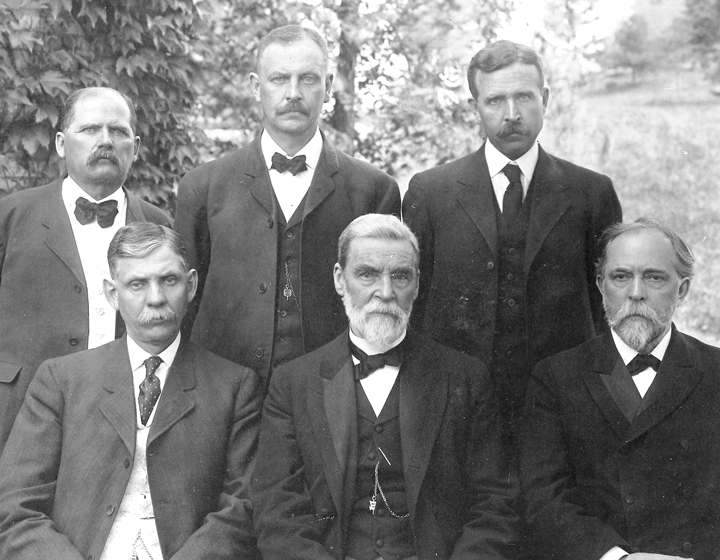 The Cornell University College of Veterinary Medicine has been working for over 150 years to keep animals and people healthy.
The Cornell University College of Veterinary Medicine has been working for over 150 years to keep animals and people healthy.
The history of teaching veterinary medicine at Cornell predates the establishment of the college in 1894. Shortly after the university was founded in 1865, Ezra Cornell insisted that a chair of veterinary medicine be instituted. He instructed Andrew D. White, the university's first president, to seek the best-qualified person to teach courses in veterinary medicine and surgery.
President White secured the services of Dr. James Law, a distinguished veterinarian and teacher and graduate of the Edinburgh Veterinary College in Scotland. Law brought with him a commitment to rigorous training for veterinarians. At Law's urging, Cornell set much higher requirements for a veterinary degree than any other institution at that time.
In 1871, the University Faculty passed a resolution requiring four years of study for a bachelor of veterinary science (B.V.S.) degree and an additional two years for a doctor of veterinary medicine (D.V.M.), a degree previously unavailable from any institution in the United States.
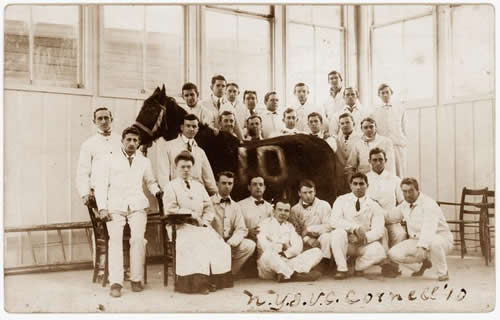 When the university opened in the fall of 1868, Dr. Law's first classes included students who were working toward degrees in agriculture and the biological sciences, and a few "special students" who were pursuing veterinary degrees. In 1871 Myron Kasson earned the University's first B.V.S. degree. He was followed very quickly, in 1872, by Daniel Salmon. Four years later Salmon earned the first D.V.M. degree in the country. Salmon went on to serve as the founding chief of the U.S. Bureau of Animal Industry and is best known today for identifying the infectious pathogen Salmonella and pioneering the fight against contagious diseases.
When the university opened in the fall of 1868, Dr. Law's first classes included students who were working toward degrees in agriculture and the biological sciences, and a few "special students" who were pursuing veterinary degrees. In 1871 Myron Kasson earned the University's first B.V.S. degree. He was followed very quickly, in 1872, by Daniel Salmon. Four years later Salmon earned the first D.V.M. degree in the country. Salmon went on to serve as the founding chief of the U.S. Bureau of Animal Industry and is best known today for identifying the infectious pathogen Salmonella and pioneering the fight against contagious diseases.
For the next 20 years, James Law lobbied state legislators for funding to expand Cornell's veterinary program into a genuine college. A gauntlet of letters, visits, speeches and editorials finally paid off in the spring of 1894. On March 21, New York State Governor Roswell P. Flower signed the legislation that chartered the veterinary college as the first state-supported college at Cornell University. Flower himself had grown up on a farm and knew the needs of livestock owners and the dangers to human health from diseased animals and their products. Thus, in recognition of the importance of veterinary medicine to the health of the state's citizens, the New York State Veterinary College was established at Cornell.
See this presentation on CVM's history given by Corey Ryan Earle '07 at the 2023 Reunion.
Timeline of key college events and milestones:
View our illustrated timeline and choose Veterinary Medicine from the colleges & schools dropdown.
1868: Cornell University opens and Dr. James Law is appointed first professor of veterinary medicine. His first classes included students who were working toward degrees in agriculture and the biological sciences, and a few "special students" who were pursuing veterinary degrees.
 1870: Horace K. White Prize established to honor veterinary students who have achieved the highest academic record during their training.
1870: Horace K. White Prize established to honor veterinary students who have achieved the highest academic record during their training.
1871: University Faculty passes a resolution requiring four years of study for a bachelor of veterinary science (B.V.S.) degree and an additional two years for a doctor of veterinary medicine (D.V.M.), a degree previously unavailable from any institution in the United States. Myron Kasson earns the university's first B.V.S. degree.
1872: Daniel Salmon is the second student to earn a Cornell B.V.S. degree.
1876: Salmon earns the first D.V.M. degree in the country. He would go on to serve as the founding chief of the U.S. Bureau of Animal Industry. He is best known today as the namesake of the infectious pathogen Salmonella and pioneering the fight against contagious diseases.
1891: Cornell graduates Drs. Theobald Smith, Fred Kilborn and Cooper Curtice discover the transmission of disease by arthropod vectors.
1892: Jacob Gould Schurman inaugurated as third president of Cornell.
1894: The New York State Veterinary College is established at Cornell. Thanks to James Law’s tireless lobbying of state legislators, New York State Governor Roswell P. Flower signed the legislation that chartered the veterinary college as the first state-supported college at Cornell University. The original appropriation to house and equip the new college was $50,000.
1896: The first building at Cornell dedicated entirely to veterinary medicine opens its doors. Aptly named James Law Hall, the building had classroom space, laboratories, a library and a museum. When classes began in the fall of 1896, there were six professors, two instructors and 11 students. The faculty were hand-picked by Law and represented the finest scholarship in their fields. The students were also expected to arrive well-prepared. The scholastic requirement for entrance was a high school diploma, a high standard at the time.
1908: First veterinary ambulatory clinic in the country is established by Professor Walter Williams and Dr. James Frost.
1910: Florence Kimball, the first woman in the United States to receive the D.V.M. degree, graduates from Cornell. Seven of the first 11 women to become licensed veterinarians in this country were Cornell graduates.
1911: First issue of The Cornell Veterinarian published. It became an independent publication in 1914 and was issued quarterly until it ceased publication in 1994.
1912: The Veterinary Diagnostic Laboratory (which would later become the Animal Health Diagnostic Center) is established, one of the first of its kind in the nation. It became the state laboratory for animal health in 1966 under a contract with the New York State Department of Agriculture and Markets. Dr. Kirksey L. Curd is the Cornell's first African-American D.V.M. graduate.
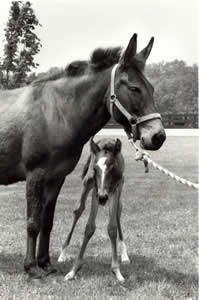 1913: New clinic buildings are completed, including a central four-story Large Animal Medical Building and two three-story buildings for the Small Animal Clinic and Farriery; these buildings are now occupied by the School of Industrial and Labor Relations.
1913: New clinic buildings are completed, including a central four-story Large Animal Medical Building and two three-story buildings for the Small Animal Clinic and Farriery; these buildings are now occupied by the School of Industrial and Labor Relations.
1925: Phi Zeta Veterinary Honor Society founded at Cornell, with Cornell continuing as the Alpha Chapter other schools join.
1938: The Moore Laboratory is completed. Named in honor of Dr. Veranus Alva Moore, the college's second dean, it housed the Departments of Pathology and Bacteriology, Avian Diseases, and the Diagnostic Laboratory. The building is now part of Ives Hall and the Industrial Labor Relations School.
1946: New bovine virus discovered.
1947: Bovine mastitis research program established, and continues today as the Quality Milk Production Services within the Animal Health Diagnostic Center & New York State Veterinary Diagnostic Laboratory.
1950 & 1952: Veterinary Virus Research Institute & James A. Baker Institute are founded.
1957: The college moves to its present site at the east end of Tower Road.
1960: Vaccine for canine distemper developed.
1966: Veterinary College annual Open House launched. The Veterinary Diagnostic Laboratory becomes the New York State Veterinary Diagnostic Laboratory under a contract with the New York State Department of Agriculture and Markets.
1970: Coggins test developed by Dr. Leroy Coggins and colleagues.
1974: Cornell Feline Health Center is established. First practical test for diagnosis of canine brucellosis developed at the Baker Institute. The nine-story Veterinary Research Tower is completed.
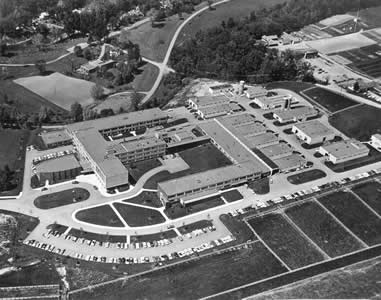 1975-76: To meet the growing diagnostic needs of the state, a separate building was constructed to house the New York State Veterinary Diagnostic Laboratory, which greatly increased our capacity to provide practitioners with the latest in-depth laboratory diagnostic support.
1975-76: To meet the growing diagnostic needs of the state, a separate building was constructed to house the New York State Veterinary Diagnostic Laboratory, which greatly increased our capacity to provide practitioners with the latest in-depth laboratory diagnostic support.
1978: Vaccine strain of major poultry disease isolated.
1979: First vaccines for canine parvovirus-type 2 at the Baker Institute.
1980: Gender shift in the veterinary profession: more women enrolled than men at Cornell, which continues today.
1984: First successful transplantation of horse embryos in mules.
1988: Genomic basis of canine muscular dystrophy discovered.
1993: The Veterinary Education Center opens for classes, including two large lecture halls, a computer teaching laboratory and a two-story public atrium.
1993: Problem-based D.V.M. curriculum implemented.
1996: The Veterinary Medical Center and Hospital for Animals is built and dedicated, housing the hospital, four academic departments and research laboratories.
1997: Cornell researchers publish linkage map of canine genome in partnership with Fred Hutchinson Cancer Research Center.
2001: First gene therapy to restore sight in congenitally blind dog conducted by Baker Institute scientists.
2005: Shelter medicine program launched at Cornell.
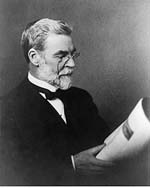 2006: A Cornell horse, Twilight, serves as genome donor for the international Equine Whole Genome Sequencing Project.
2006: A Cornell horse, Twilight, serves as genome donor for the international Equine Whole Genome Sequencing Project.
2007: The East Campus Research Facility is built, a university-wide animal facility for use by all Cornell’s life sciences.
2008: The college begins construction on the Animal Health Diagnostic Center facility, which houses the New York State Veterinary Diagnostic Laboratory. Construction concluded in 2010.
2009: Cornell-City University of Hong Kong partnership is initiated.
2011: Cornell University Veterinary Specialists, the college’s first satellite hospital, is opened in Stamford, Conn., as the largest and most comprehensive university-affiliated emergency and specialty referral center in the nation.
2012: The Teaching Dairy Barn opens as a state-of-the-art facility.
2014: Cornell Ruffian Equine Specialists opens near the historic Belmont Park on Long Island, extending the reach of the Cornell Equine Hospital.
2015: Cornell and the City University of Hong Kong establish the first school of veterinary medicine in Hong Kong.
2016: Research at Baker Institute leads to the first puppies born by in vitro fertilization.
2017: College launches master of professional studies in veterinary medical sciences as a new degree program; the first concentration being offered is veterinary parasitology.
2017: College launches Cornell's first Masters of Public Health Program. First D.V.M. class with the newly-expanded size of 120 students begins classes. New renovations to college spaces are completed, providing the college with a new formal entrance from Tower Road, improved circulation, new café and grand atrium, providing new and renovated teaching spaces with the latest educational technology.
2018: Cornell's Small Animal Community Practice opens, a new 10,000 square foot building on Campus Road that functions as a family veterinary hospital and enables students to learn business and management skills.
2019: Cornell launches the Center for Veterinary Business and Entrepreneurship, an interdisciplinary program intended to spur research, training and outreach in veterinary business.
2020: The college, leveraging the Animal Health Diagnostic Center, establishes the Cornell COVID-19 Testing Laboratory (CCTL), in collaboration with the Cayuga Health System, to provide in-house COVID-19 tests for Cornell's staff, students and faculty, allowing the university to reopen and hold in-person study during the COVID-19 pandemic.
2021: College launches the Department of Public and Ecosystem Health and the Cornell Richard P. Riney Canine Health Center.
2022: College establishes the Duffield Institute for Animal Behavior.
The Archives
There is much more to the story of veterinary medicine at Cornell. The Archives of the College of Veterinary Medicine is home to a wealth of information about the history of the college and its graduates. If you have questions or comments, please contact Rare and Manuscript Collections.


